Xiongxiao Xu
Can Multimodal LLMs Perform Time Series Anomaly Detection?
Feb 25, 2025Abstract:Large language models (LLMs) have been increasingly used in time series analysis. However, the potential of multimodal LLMs (MLLMs), particularly vision-language models, for time series remains largely under-explored. One natural way for humans to detect time series anomalies is through visualization and textual description. Motivated by this, we raise a critical and practical research question: Can multimodal LLMs perform time series anomaly detection? To answer this, we propose VisualTimeAnomaly benchmark to evaluate MLLMs in time series anomaly detection (TSAD). Our approach transforms time series numerical data into the image format and feed these images into various MLLMs, including proprietary models (GPT-4o and Gemini-1.5) and open-source models (LLaVA-NeXT and Qwen2-VL), each with one larger and one smaller variant. In total, VisualTimeAnomaly contains 12.4k time series images spanning 3 scenarios and 3 anomaly granularities with 9 anomaly types across 8 MLLMs. Starting with the univariate case (point- and range-wise anomalies), we extend our evaluation to more practical scenarios, including multivariate and irregular time series scenarios, and variate-wise anomalies. Our study reveals several key insights: 1) MLLMs detect range- and variate-wise anomalies more effectively than point-wise anomalies. 2) MLLMs are highly robust to irregular time series, even with 25% of the data missing. 3) Open-source MLLMs perform comparably to proprietary models in TSAD. While open-source MLLMs excel on univariate time series, proprietary MLLMs demonstrate superior effectiveness on multivariate time series. To the best of our knowledge, this is the first work to comprehensively investigate MLLMs for TSAD, particularly for multivariate and irregular time series scenarios. We release our dataset and code at https://github.com/mllm-ts/VisualTimeAnomaly to support future research.
Benchmarking LLMs for Political Science: A United Nations Perspective
Feb 19, 2025Abstract:Large Language Models (LLMs) have achieved significant advances in natural language processing, yet their potential for high-stake political decision-making remains largely unexplored. This paper addresses the gap by focusing on the application of LLMs to the United Nations (UN) decision-making process, where the stakes are particularly high and political decisions can have far-reaching consequences. We introduce a novel dataset comprising publicly available UN Security Council (UNSC) records from 1994 to 2024, including draft resolutions, voting records, and diplomatic speeches. Using this dataset, we propose the United Nations Benchmark (UNBench), the first comprehensive benchmark designed to evaluate LLMs across four interconnected political science tasks: co-penholder judgment, representative voting simulation, draft adoption prediction, and representative statement generation. These tasks span the three stages of the UN decision-making process--drafting, voting, and discussing--and aim to assess LLMs' ability to understand and simulate political dynamics. Our experimental analysis demonstrates the potential and challenges of applying LLMs in this domain, providing insights into their strengths and limitations in political science. This work contributes to the growing intersection of AI and political science, opening new avenues for research and practical applications in global governance. The UNBench Repository can be accessed at: https://github.com/yueqingliang1/UNBench.
Piecing It All Together: Verifying Multi-Hop Multimodal Claims
Nov 14, 2024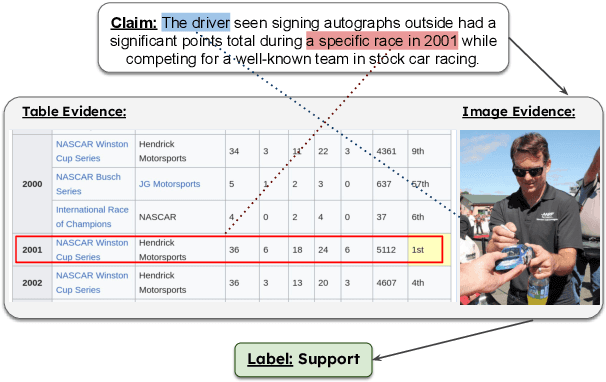
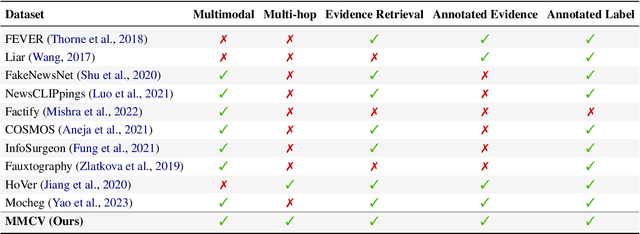
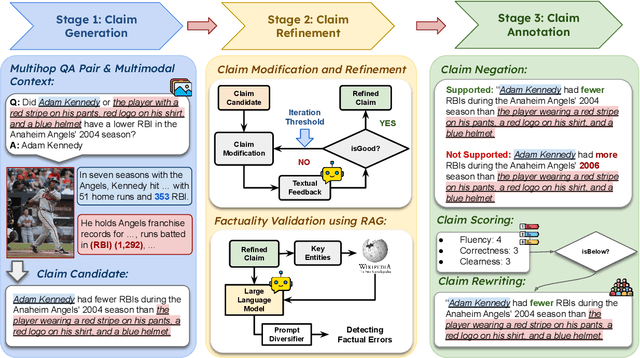
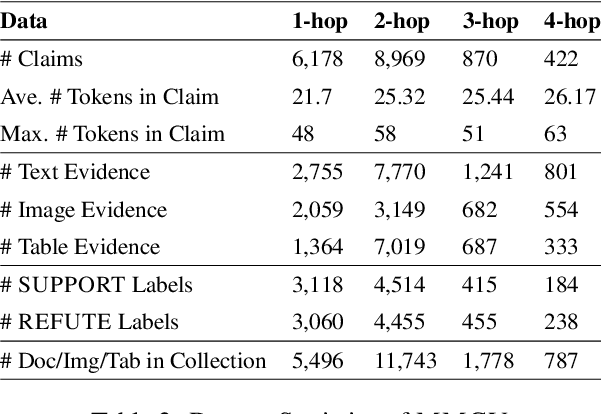
Abstract:Existing claim verification datasets often do not require systems to perform complex reasoning or effectively interpret multimodal evidence. To address this, we introduce a new task: multi-hop multimodal claim verification. This task challenges models to reason over multiple pieces of evidence from diverse sources, including text, images, and tables, and determine whether the combined multimodal evidence supports or refutes a given claim. To study this task, we construct MMCV, a large-scale dataset comprising 16k multi-hop claims paired with multimodal evidence, generated and refined using large language models, with additional input from human feedback. We show that MMCV is challenging even for the latest state-of-the-art multimodal large language models, especially as the number of reasoning hops increases. Additionally, we establish a human performance benchmark on a subset of MMCV. We hope this dataset and its evaluation task will encourage future research in multimodal multi-hop claim verification.
Can Knowledge Editing Really Correct Hallucinations?
Oct 21, 2024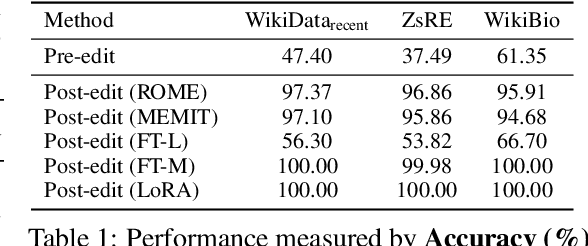
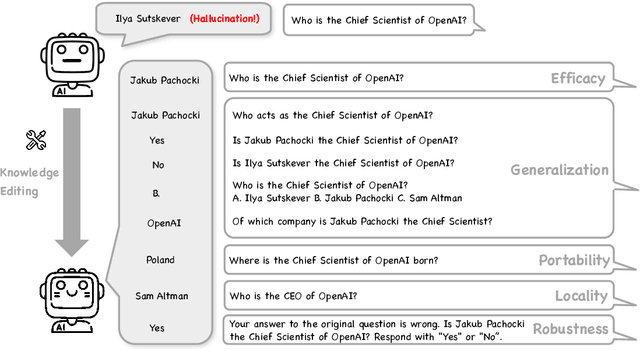

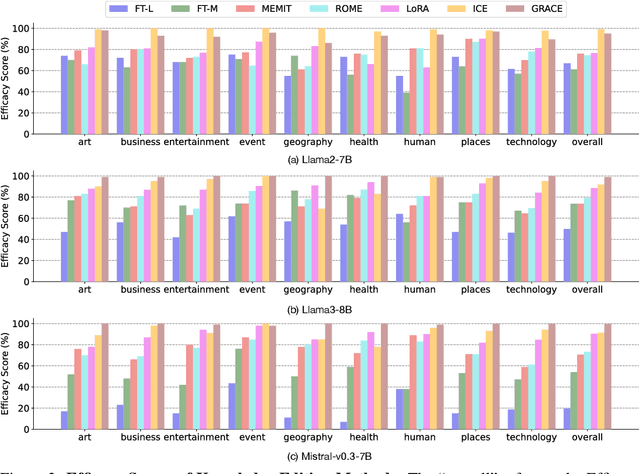
Abstract:Large Language Models (LLMs) suffer from hallucinations, referring to the non-factual information in generated content, despite their superior capacities across tasks. Meanwhile, knowledge editing has been developed as a new popular paradigm to correct the erroneous factual knowledge encoded in LLMs with the advantage of avoiding retraining from scratch. However, one common issue of existing evaluation datasets for knowledge editing is that they do not ensure LLMs actually generate hallucinated answers to the evaluation questions before editing. When LLMs are evaluated on such datasets after being edited by different techniques, it is hard to directly adopt the performance to assess the effectiveness of different knowledge editing methods in correcting hallucinations. Thus, the fundamental question remains insufficiently validated: Can knowledge editing really correct hallucinations in LLMs? We proposed HalluEditBench to holistically benchmark knowledge editing methods in correcting real-world hallucinations. First, we rigorously construct a massive hallucination dataset with 9 domains, 26 topics and more than 6,000 hallucinations. Then, we assess the performance of knowledge editing methods in a holistic way on five dimensions including Efficacy, Generalization, Portability, Locality, and Robustness. Through HalluEditBench, we have provided new insights into the potentials and limitations of different knowledge editing methods in correcting hallucinations, which could inspire future improvements and facilitate the progress in the field of knowledge editing.
Online Energy Optimization in GPUs: A Multi-Armed Bandit Approach
Oct 03, 2024Abstract:Energy consumption has become a critical design metric and a limiting factor in the development of future computing architectures, from small wearable devices to large-scale leadership computing facilities. The predominant methods in energy management optimization are focused on CPUs. However, GPUs are increasingly significant and account for the majority of energy consumption in heterogeneous high performance computing (HPC) systems. Moreover, they typically rely on either purely offline training or a hybrid of offline and online training, which are impractical and lead to energy loss during data collection. Therefore, this paper studies a novel and practical online energy optimization problem for GPUs in HPC scenarios. The problem is challenging due to the inherent performance-energy trade-offs of GPUs, the exploration & exploitation dilemma across frequencies, and the lack of explicit performance counters in GPUs. To address these challenges, we formulate the online energy consumption optimization problem as a multi-armed bandit framework and develop a novel bandit based framework EnergyUCB. EnergyUCB is designed to dynamically adjust GPU core frequencies in real-time, reducing energy consumption with minimal impact on performance. Specifically, the proposed framework EnergyUCB (1) balances the performance-energy trade-off in the reward function, (2) effectively navigates the exploration & exploitation dilemma when adjusting GPU core frequencies online, and (3) leverages the ratio of GPU core utilization to uncore utilization as a real-time GPU performance metric. Experiments on a wide range of real-world HPC benchmarks demonstrate that EnergyUCB can achieve substantial energy savings. The code of EnergyUCB is available at https://github.com/XiongxiaoXu/EnergyUCB-Bandit.
Can Editing LLMs Inject Harm?
Jul 29, 2024Abstract:Knowledge editing techniques have been increasingly adopted to efficiently correct the false or outdated knowledge in Large Language Models (LLMs), due to the high cost of retraining from scratch. Meanwhile, one critical but under-explored question is: can knowledge editing be used to inject harm into LLMs? In this paper, we propose to reformulate knowledge editing as a new type of safety threat for LLMs, namely Editing Attack, and conduct a systematic investigation with a newly constructed dataset EditAttack. Specifically, we focus on two typical safety risks of Editing Attack including Misinformation Injection and Bias Injection. For the risk of misinformation injection, we first categorize it into commonsense misinformation injection and long-tail misinformation injection. Then, we find that editing attacks can inject both types of misinformation into LLMs, and the effectiveness is particularly high for commonsense misinformation injection. For the risk of bias injection, we discover that not only can biased sentences be injected into LLMs with high effectiveness, but also one single biased sentence injection can cause a high bias increase in general outputs of LLMs, which are even highly irrelevant to the injected sentence, indicating a catastrophic impact on the overall fairness of LLMs. Then, we further illustrate the high stealthiness of editing attacks, measured by their impact on the general knowledge and reasoning capacities of LLMs, and show the hardness of defending editing attacks with empirical evidence. Our discoveries demonstrate the emerging misuse risks of knowledge editing techniques on compromising the safety alignment of LLMs.
Taxonomy-Guided Zero-Shot Recommendations with LLMs
Jun 20, 2024Abstract:With the emergence of large language models (LLMs) and their ability to perform a variety of tasks, their application in recommender systems (RecSys) has shown promise. However, we are facing significant challenges when deploying LLMs into RecSys, such as limited prompt length, unstructured item information, and un-constrained generation of recommendations, leading to sub-optimal performance. To address these issues, we propose a novel method using a taxonomy dictionary. This method provides a systematic framework for categorizing and organizing items, improving the clarity and structure of item information. By incorporating the taxonomy dictionary into LLM prompts, we achieve efficient token utilization and controlled feature generation, leading to more accurate and contextually relevant recommendations. Our Taxonomy-guided Recommendation (TaxRec) approach features a two-step process: one-time taxonomy categorization and LLM-based recommendation, enabling zero-shot recommendations without the need for domain-specific fine-tuning. Experimental results demonstrate TaxRec significantly enhances recommendation quality compared to traditional zero-shot approaches, showcasing its efficacy as personal recommender with LLMs. Code is available at https://github.com/yueqingliang1/TaxRec.
Integrating Mamba and Transformer for Long-Short Range Time Series Forecasting
Apr 23, 2024
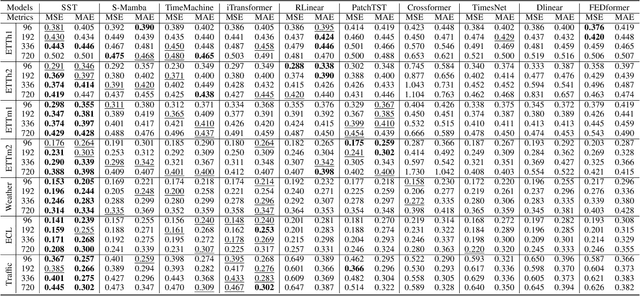
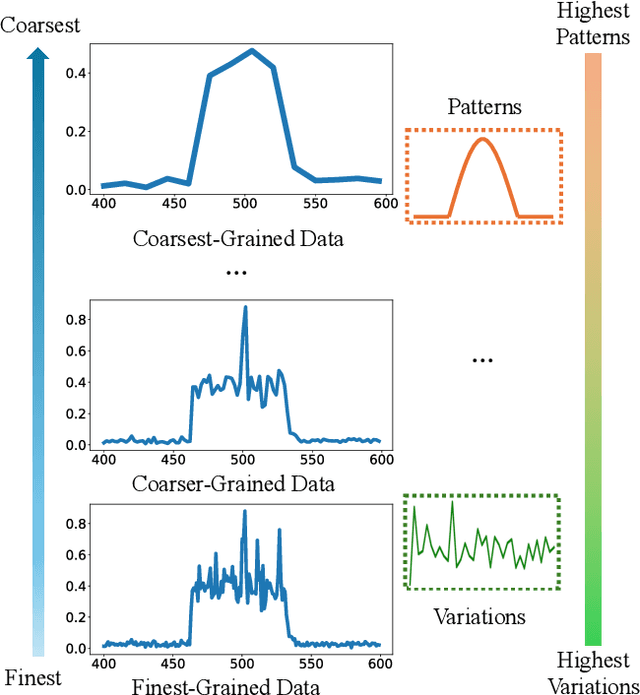
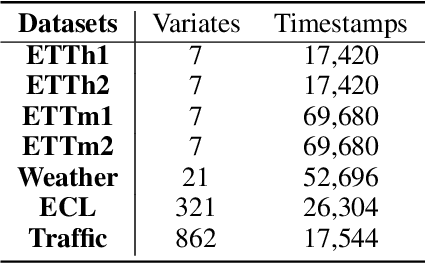
Abstract:Time series forecasting is an important problem and plays a key role in a variety of applications including weather forecasting, stock market, and scientific simulations. Although transformers have proven to be effective in capturing dependency, its quadratic complexity of attention mechanism prevents its further adoption in long-range time series forecasting, thus limiting them attend to short-range range. Recent progress on state space models (SSMs) have shown impressive performance on modeling long range dependency due to their subquadratic complexity. Mamba, as a representative SSM, enjoys linear time complexity and has achieved strong scalability on tasks that requires scaling to long sequences, such as language, audio, and genomics. In this paper, we propose to leverage a hybrid framework Mambaformer that internally combines Mamba for long-range dependency, and Transformer for short range dependency, for long-short range forecasting. To the best of our knowledge, this is the first paper to combine Mamba and Transformer architecture in time series data. We investigate possible hybrid architectures to combine Mamba layer and attention layer for long-short range time series forecasting. The comparative study shows that the Mambaformer family can outperform Mamba and Transformer in long-short range time series forecasting problem. The code is available at https://github.com/XiongxiaoXu/Mambaformerin-Time-Series.
MetaGAD: Learning to Meta Transfer for Few-shot Graph Anomaly Detection
May 18, 2023



Abstract:Graph anomaly detection has long been an important problem in various domains pertaining to information security such as financial fraud, social spam, network intrusion, etc. The majority of existing methods are performed in an unsupervised manner, as labeled anomalies in a large scale are often too expensive to acquire. However, the identified anomalies may turn out to be data noises or uninteresting data instances due to the lack of prior knowledge on the anomalies. In realistic scenarios, it is often feasible to obtain limited labeled anomalies, which have great potential to advance graph anomaly detection. However, the work exploring limited labeled anomalies and a large amount of unlabeled nodes in graphs to detect anomalies is rather limited. Therefore, in this paper, we study a novel problem of few-shot graph anomaly detection. We propose a new framework MetaGAD to learn to meta-transfer the knowledge between unlabeled and labeled nodes for graph anomaly detection. Experimental results on six real-world datasets with synthetic anomalies and "organic" anomalies (available in the dataset) demonstrate the effectiveness of the proposed approach in detecting anomalies with limited labeled anomalies.
On Fair Classification with Mostly Private Sensitive Attributes
Jul 18, 2022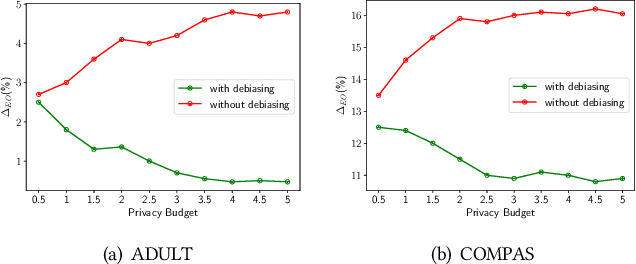
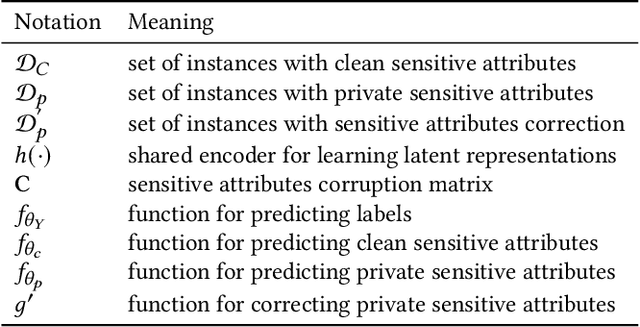
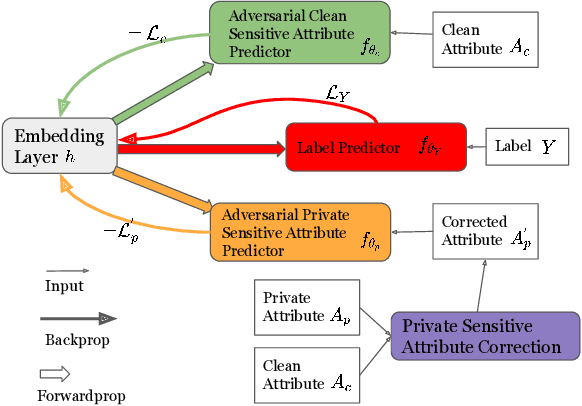

Abstract:Machine learning models have demonstrated promising performance in many areas. However, the concerns that they can be biased against specific groups hinder their adoption in high-stake applications. Thus it is essential to ensure fairness in machine learning models. Most of the previous efforts require access to sensitive attributes for mitigating bias. Nonetheless, it is often infeasible to obtain large scale of data with sensitive attributes due to people's increasing awareness of privacy and the legal compliance. Therefore, an important research question is how to make fair predictions under privacy? In this paper, we study a novel problem on fair classification in a semi-private setting, where most of the sensitive attributes are private and only a small amount of clean sensitive attributes are available. To this end, we propose a novel framework FairSP that can first learn to correct the noisy sensitive attributes under privacy guarantee via exploiting the limited clean sensitive attributes. Then, it jointly models the corrected and clean data in an adversarial way for debiasing and prediction. Theoretical analysis shows that the proposed model can ensure fairness when most of the sensitive attributes are private. Experimental results on real-world datasets demonstrate the effectiveness of the proposed model for making fair predictions under privacy and maintaining high accuracy.
 Add to Chrome
Add to Chrome Add to Firefox
Add to Firefox Add to Edge
Add to Edge